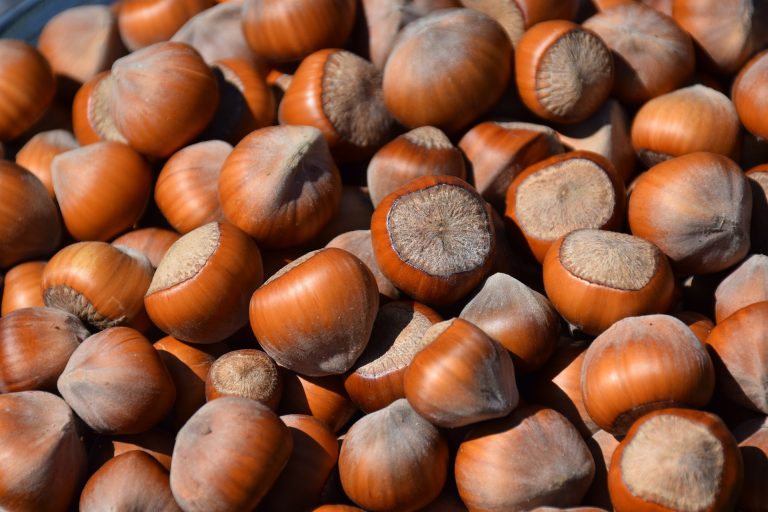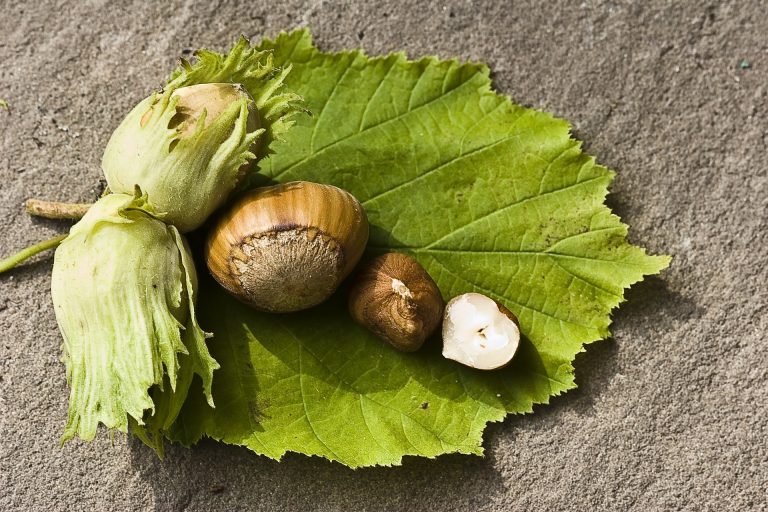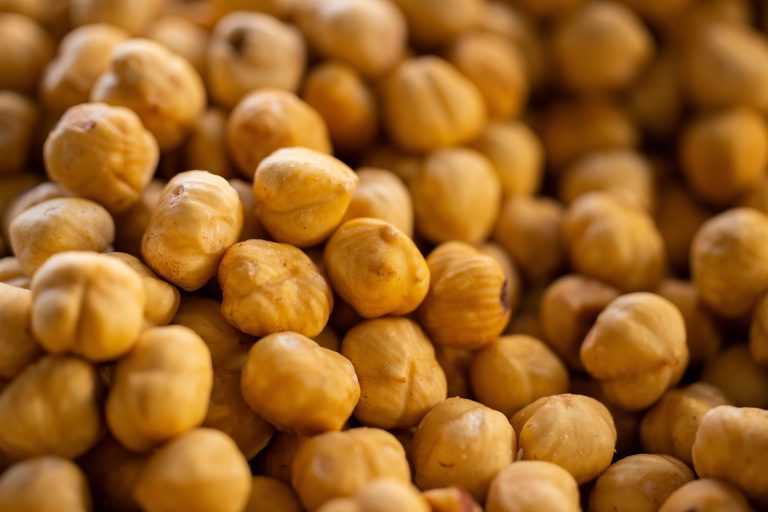Hazelnut : Botanical Insights, Culinary Delights, and Health Benefits
Introduction
Hazelnut, scientifically known as Corylus avellana, is a versatile and nutritious nut that has been cherished for centuries across various cultures. This article delves into the botanical characteristics, historical significance, culinary uses, health benefits, and economic importance of hazelnuts, providing a comprehensive overview of its role in agriculture, cuisine, and human nutrition.
Botanical Characteristics
Hazelnut trees belong to the genus Corylus within the Betulaceae family. They are deciduous shrubs or small trees that typically grow to heights ranging from 3 to 8 meters (10 to 26 feet). Hazelnut leaves are rounded, serrated, and alternate along the branches. The bark of mature trees is smooth and grey-brown, while younger branches often feature fine hairs.
Hazelnuts themselves are small, round to oval-shaped nuts encased in a hard, woody shell that is often covered by a husk. The nuts range in size from 1 to 2 centimeters (0.4 to 0.8 inches) and are characterized by their rich, buttery flavor when roasted.
Hazelnut trees are native to Europe and Asia but have been cultivated worldwide in temperate regions with well-drained soils and moderate climates. They thrive in areas with cool winters and mild summers, making them well-suited for cultivation in regions such as Turkey, Italy, the United States (Oregon being a prominent producer), and the Caucasus region.

Cultivation and Harvesting
The cultivation of hazelnuts involves several stages, from planting to harvesting:
- Propagation: Hazelnut trees are propagated through seeds or by grafting desirable varieties onto rootstocks. Seedlings are typically grown in nurseries before being transplanted into orchards.
- Planting: Hazelnut trees prefer well-drained soils with a pH range of 5.5 to 7.5. They are planted in rows to facilitate pollination and harvesting. Proper spacing ensures adequate light penetration and airflow, which are essential for tree health and nut production.
- Pollination: Most hazelnut varieties are monoecious, meaning they have separate male and female flowers on the same tree. Pollination is primarily achieved by wind, although some varieties benefit from cross-pollination between different cultivars to enhance nut set and yield.
- Management: Hazelnut orchards require regular irrigation, especially during dry periods, to support tree growth and nut development. Pruning is essential to maintain tree structure, promote air circulation, and facilitate harvesting. Pest and disease management practices are implemented to protect orchards from common threats such as insects, fungi, and bacterial infections.
- Harvesting: Hazelnuts mature in late summer to early autumn, depending on the cultivar and growing region. Harvesting involves shaking the trees or using mechanical harvesters to dislodge ripe nuts from the branches. Nuts are collected from the ground and undergo processing to remove husks and dry the kernels to optimal moisture levels for storage.
Culinary Uses
Hazelnuts are renowned for their rich flavor and versatility in culinary applications:
- Roasted Nuts: Roasted hazelnuts are a popular snack enjoyed on their own or as an ingredient in various recipes. The roasting process enhances their nutty aroma and crunchy texture, making them a delightful addition to salads, granolas, and baked goods.
- Nut Butters and Spreads: Hazelnuts are commonly used to make creamy nut butters and spreads, such as hazelnut butter and chocolate-hazelnut spreads like Nutella. These products are favored for their smooth consistency and indulgent taste.
- Baking and Desserts: Ground hazelnuts or hazelnut flour are used in baking to impart a nutty flavor and moist texture to cakes, cookies, and pastries. Hazelnuts also complement chocolate desserts, mousses, and ice creams, adding depth and richness to sweet treats.
- Savory Dishes: Crushed or chopped hazelnuts are used as a crunchy topping for savory dishes such as salads, roasted vegetables, and pasta dishes. Their nutty flavor pairs well with meats, cheeses, and vegetables, enhancing the overall taste and texture of savory recipes.

Nutritional Value and Health Benefits
Hazelnuts are nutritionally dense nuts that offer a range of health benefits:
- Macronutrients: Hazelnuts are rich in healthy fats, primarily monounsaturated and polyunsaturated fats, which support heart health by lowering LDL cholesterol levels. They are also a good source of protein and dietary fiber, promoting satiety and digestive health.
- Vitamins and Minerals: Hazelnuts are a significant source of vitamin E, an antioxidant that protects cells from oxidative damage. They also provide essential minerals such as magnesium, copper, and manganese, which play roles in energy metabolism, bone health, and antioxidant defense systems.
- Phytochemicals: Hazelnuts contain phytochemicals such as flavonoids and phenolic compounds, which have anti-inflammatory and antioxidant properties. These compounds contribute to reducing chronic inflammation and oxidative stress, thereby lowering the risk of chronic diseases.
- Cardiovascular Health: Regular consumption of hazelnuts has been associated with improved cardiovascular health outcomes, including reduced blood pressure, improved lipid profiles, and enhanced vascular function. These benefits are attributed to the nut’s nutrient profile and bioactive compounds.
- Weight Management: Despite their calorie density, hazelnuts can support weight management when consumed in moderation. Their combination of healthy fats, protein, and fiber helps promote feelings of fullness and satiety, reducing overall calorie intake.
Economic Importance
Hazelnuts play a significant role in global agriculture and trade, contributing to local economies and international markets:
- Global Production: Turkey is the leading producer of hazelnuts worldwide, followed by Italy, the United States (particularly Oregon), and other countries in Europe and Asia. Hazelnut production supports rural livelihoods and agricultural communities in these regions.
- Export Market: Hazelnuts are traded globally as raw nuts, processed products, and value-added ingredients. Major importing countries include the United States, European Union member states, and emerging markets in Asia and the Middle East. Hazelnut exports contribute to national economies and foreign exchange earnings for producing countries.
- Industry Growth: The hazelnut industry continues to expand due to increasing consumer demand for nuts as healthy snacks and ingredients in food manufacturing. Investments in orchard management practices, processing technologies, and market diversification strategies are driving growth and innovation in the sector.
- Sustainability Challenges: Hazelnut cultivation faces sustainability challenges related to water use efficiency, soil conservation, and biodiversity conservation. Adopting sustainable farming practices, such as integrated pest management and agroforestry systems, can mitigate environmental impacts and enhance long-term resilience.

Cultural Significance and Traditions
Hazelnuts have historical and cultural significance in various traditions and folklore:
- Mythology and Symbolism: In ancient mythology, hazelnuts were associated with wisdom, fertility, and protection. They were considered sacred in some cultures and used in rituals and ceremonies to invoke blessings and ensure prosperity.
- Folklore and Superstitions: Hazelnuts have been featured in folklore and superstitions as symbols of good luck, divination, and supernatural protection. They were often carried as talismans or incorporated into charms to ward off evil spirits and bring fortune.
- Seasonal Celebrations: Hazelnuts were historically celebrated during harvest festivals and seasonal gatherings as a symbol of abundance and gratitude for the harvest bounty. Their inclusion in traditional dishes and festive treats underscores their cultural importance and enduring popularity.
Challenges and Future Directions
Despite its popularity and nutritional benefits, the hazelnut industry faces several challenges and considerations for sustainable development:
- Climate Change: Hazelnut cultivation is vulnerable to climate variability, including temperature fluctuations, erratic rainfall patterns, and extreme weather events. Climate-smart agricultural practices and resilient crop varieties are essential for adapting to changing environmental conditions.
- Pest and Disease Management: Hazelnut orchards are susceptible to pests and diseases, such as eastern filbert blight and insect infestations, which can impact yield and quality. Integrated pest management strategies and disease-resistant cultivars are critical for mitigating these risks.
- Market Dynamics: Price volatility, trade tariffs, and market access barriers pose challenges for hazelnut growers and exporters. Diversifying market channels, enhancing product differentiation, and strengthening international partnerships can mitigate market risks and enhance competitiveness.
- Sustainable Practices: Promoting sustainable farming practices, enhancing soil health, conserving water resources, and preserving biodiversity are integral to ensuring the long-term viability of hazelnut cultivation and protecting natural ecosystems.
Conclusion
In conclusion, hazelnut exemplifies a nut species rich in botanical diversity, culinary versatility, nutritional value, and cultural significance. From its origins in temperate regions to its global presence in agriculture and cuisine, hazelnuts continue to captivate consumers, chefs, and agricultural communities worldwide.
By embracing sustainable practices, promoting health benefits, fostering cultural traditions, and addressing challenges, stakeholders can ensure a resilient and sustainable future for the hazelnut industry. Through research, innovation, and collective action, hazelnuts can continue to thrive as a cherished nut variety, enriching diets, economies, and cultural heritage for generations to come.

